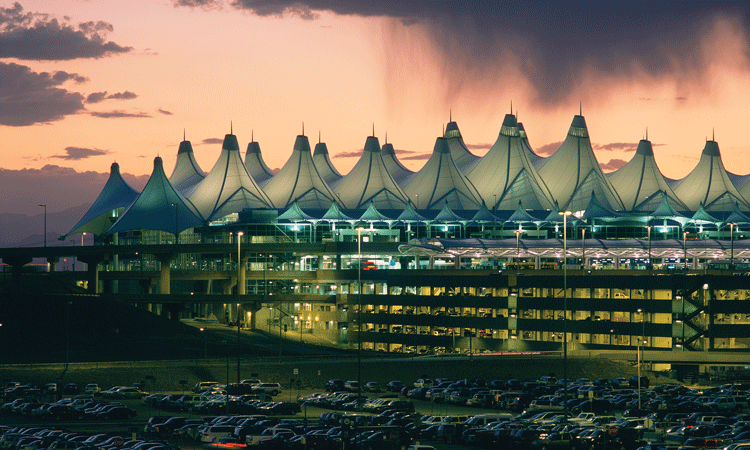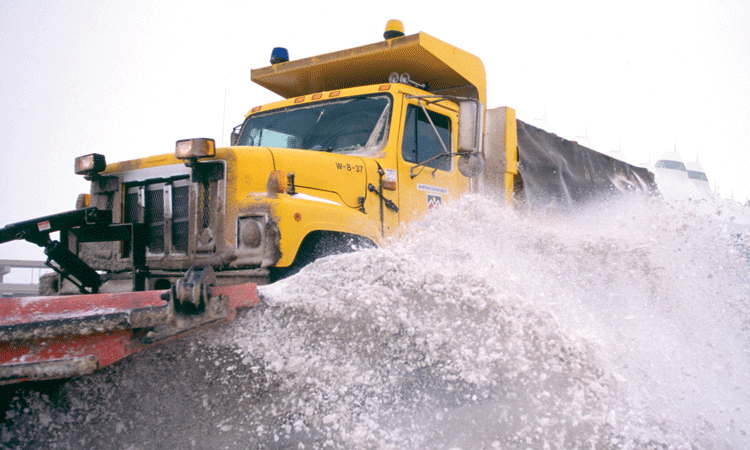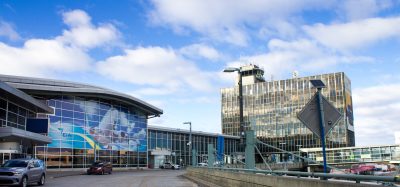Challenging winter seasons for Denver International Airport (DIA)
Posted: 21 January 2014 | Ken Greene, Mike Carlson | No comments yet
With 53 square miles of land, winter operations at Denver International Airport are challenging. Mike Carlson, Airport Operations Manager, and Ken Greene, Deputy Manager of Airport Operations, explain why the airport is prepared for the winter season


Credit: Denver International Airport (DEN)
Denver International Airport (DIA), the USA’s fifth and world’s 13th busiest airport, received 78.4 inches of snow during the 2012/2013 snow season (October – April) over the course of 33 snow events. The total accumulation was equal to 13 million cubic yards of snow, which is enough to fill the Sports Authority Field at Mile High stadium 26 times. Approximately 61.4 inches of snow was accumulated in just over a two-month period, from 20 February – 1 May 2013. The average snowfall for a season is approximately 57.5 inches.
“Our job is to keep our airside (runways, taxiways, and ramp areas) and landside (Peña Boulevard, adjacent roads, and parking lots) locations clear of snow so passengers can safely get to their destinations,” explains Ken Greene, Deputy Manager of Airport Operations. “As a critical part of the national airspace system, it is very important that we keep operations moving safely.”
Snow operations are a challenge at DIA, in part, because of the sheer size of the airport. To put this into perspective, the four busiest airports in the United States – Hartsfield-Jackson Atlanta, Chicago O’Hare, Los Angeles International, and Dallas-Fort Worth – could collectively fit into DIA’s 53 square miles of land. And as such, the DIA snow removal crews are responsible for cleaning:
- 250 lane miles of roadway – equal to the distance between Denver and Grand Junction
- Six runways, multiple taxiways and ramp areas (over 55 million square feet)
- 30 acres of parking, which is the equivalent to 23 football fields
- 40,000 parking spaces, nearly equal to all the metered parking spaces in downtown Denver.
Resources are crucial
DIA has 500 trained snow removal personnel and approximately 270 pieces of snow removal equipment. The airside fleet includes Multi-Function Equipment (MFE), blowers, brooms, blades, ploughs, runway sanders, snow melters, 5,000-gallon chemical trucks, and loaders with box ploughs. The landside fleet includes ploughs, tractor-ploughs, sand/liquid spreaders, loaders with box ploughs, chemical trucks, bobcats, and bobcats with box ploughs.
The airport upgraded and expanded the snow removal fleet after the 2006 blizzards, known as the ‘Holiday Blizzards’, which were major back-to-back storms during the last two weeks of December that year. The blizzards produced snow drifts in some areas of Denver that reached up to five feet. After these storms, DIA purchased MFE that is designed to plough, sweep, and blow snow, with some fitted to spread liquid de-ice and sand products. DIA also has two different types of snow melters – 10 that melt 600 tons of snow an hour, and one that melts 150 tons of snow an hour. For example, in October 2010 a large snowstorm produced approximately 15 inches of snow on the airport, and snow removal crews melted 72,000 tons of snow.
Prioritising snow removal routes
Following the 2006 Holiday Blizzards, the entire airport was mapped out in a manner that established the prioritisation of snow removal activities. Specifically, the airfield pavement was prioritised into three categories with ‘Priority 1’ surfaces having the highest priority and ‘Priority 3’ surfaces the lowest.
This system enables the airfield crews to keep the essential runways and ramps open. For example, prevailing northerly winds are associated with winter storms at the airport. These northerly winds can render east-west runways useless to aircraft due to crosswind limitations. By not using the two east-west runways, snow removal crews are able to concentrate on the four north-south runways. Two teams (one runway team, one taxiway team) handle the east airfield, and two teams handle the west airfield. The airport also uses a contractor to perform the ramp area snow removal, which allows airport personnel to be assigned to the other airfield teams. In all, there are nine teams dedicated to specific areas of the airfield. Runway occupancy times (which are the length of time that it takes to clear a runway) have decreased from an average of 45 minutes during the 2006-2007 snow season to an average of 15 minutes over the past two snow seasons.
Staffing according to the Snow Alert Level
Another improvement to the DIA Snow Plan following the 2006 blizzards was the establishment of different levels of snow alerts. These alerts are based on a total forecasted runway surface accumulation during a 12-hour operational period and include a pre-determined level of staffing associated with each snow alert level. There are four different snow alert levels at DIA.
For the different Snow Alert levels, airport operations and field maintenance teams organise staff according to the forecasted accumulations.
Snowman
The Snowman position is another enhancement that was made to the DIA Snow Plan following the 2006 blizzards. The Snowman is an assigned position held by a qualified Airfield Operations Manager (AOM) who reports to the Air Traffic Control Tower (ATCT) at the beginning of a Snow Alert Level A or higher. The Snowman provides a single point of contact for the FAA with Airport Operations and coordinates the snow removal operation with the AOMs out in the field. This position has streamlined the coordination between the snow removal team and the FAA, and has bolstered the relationship and level of trust between Airport Operations and the FAA. The Snowman also participates in the FAA’s Command Center conference call, which is held every two hours throughout the day, to provide insight into the airport’s snow removal plan and provides the FAA and stakeholders with the ability to give input to the plan.
Airport Operations also communicate with the airport community via the use of a web-based program called OPSnet, which provides airport management with the ability to instantly communicate and share information with the airport community. For example, active or planned snow removal operations, current runway conditions and real-time arrival and departure demand information can be acquired using OPSnet.


During the 2012/2013 winter season, 78.4 inches of snowfall had to be cleared at DIA. Photograph provided courtesy of Denver International Airport
Balanced Throughput Program
The Balanced Throughput Program, sometimes referred to as ‘Smoothing’, is a program where the number of arriving and departing flights are balanced on an hourly basis. Well in advance of the first snowflake, Airport Operations, Field Maintenance and local FAA personnel discuss the forecast, determine the capabilities of the snow removal crews based on the forecasted snowfall intensity and winds to determine how many runways will be available at any given time and then decide what an acceptable Airport Arrival Rate (AAR) will be to balance the Airport Departure Rate (ADR). This initial AAR is publicised to both the FAA Command Center and the airlines so they can begin making preparations. During the snow event, the AAR can be increased or decreased depending on the intensity of the storm.
The balanced throughput approach ‘smooths’ (or spreads) flights throughout the day in order to avoid heavy arrival and departure banks, and having the main ramp become heavily congested due to the unavailability of gates. By giving airlines notice of the proposed AAR prior to the beginning of a storm, the airlines can revise schedules, consolidate flights, make strategic cancellations and adjust crew times as needed. The program also minimises fuel consumption by aircraft that, in the past, had to wait in long de-icing queues. The de-ice pad queue lines are much shorter so aircraft are in and out of the de-ice pads in a more efficient manner, and the take-off wait at the runways is much shorter. These efficiencies also improve the passenger experience and drastically reduce the chances of violating the Passenger Bill of Rights.
From a DIA snow removal perspective, by balancing the pressure on the airport from the ‘onset’ of a storm, the airfield becomes less congested. Ultimately, this provides a safer and more efficient environment for the snow removal equipment to operate on the airfield. Balancing the flow of arrivals and departures produces a more strategic and coordinated snow removal plan.
Collecting de-icing fluid
Aircraft De-icing Fluid (ADF) is made up of a chemical called propylene glycol blended with water and additives to allow it to effectively remove ice and snow from aircraft before departure. DIA was built for glycol recovery with collection drains at concentrated de-icing areas. On-site storage infrastructure allows for efficient operation near departure runways and helps keep ADF out of the storm water system. In 2012, DIA had a 68 per cent collection rate – one of the highest rates in the country.
Technology for safety and de-icing efficiencies
DIA recently implemented an airport surface management system called Aerobahn® that enhances the movement of aircraft in the ramp areas. Saab Sensis was selected through a competitive bid process to develop a system that combines airside operational information, such as flight schedules, with the exact location and identification of aircraft on the surface of the airport and surrounding airspace for a real-time, comprehensive view of surface operations. This system is operational and several airline partners, United, Southwest, Frontier and Delta, as well as the FAA and the airport’s ramp tower, have established a common surveillance and communications platform through the use of the system.
In addition, DIA will be deploying the Saab Sensis Aerobahn® De-icing Manager to provide all airport stakeholders with a common de-icing process management tool for more efficient winter operations. The Aerobahn® De-icing Manager integrates airport surface surveillance from Saab Sensis multilateration and flight data to provide users with real-time situational awareness of de-ice pad activity. The airport, airlines and de-icing service providers can schedule and sequence aircraft into centralised de-ice pads; track de-icing queue lengths and occupancy times; and automatically record de-icing process milestones. In addition, the De-icing Manager features a number of predictive elements that facilitate better planning of the de-icing process, including estimated de-icing queue entry, pad entry, occupancy and exit times, and recommended push back times that will help limit queue lengths.
“The airport surface management system is important because time is money,” says Greene. “It is estimated that this airport surface management system will save each aircraft at least five seconds. Over a year, that translates to more than $2.3 million in fuel and operational costs. In addition to cost savings, the safety for aircraft movement is enhanced by being able to track each plane in the air and on the ground in real-time.”
Preparation is key
DIA even thinks about snow during the summer! One of the ways that the airport prepares for the snow season is by putting operators’ skills and talents to the test at the annual Aviation Snow Roadeo Competition in August. This event serves as the kick-off for DIA’s snow removal season. In order to participate in each event, employees must complete a written test on the rules of the road (and airfield), a diagnostic vehicle inspection and operate a vehicle on a timed obstacle course. The obstacles test the operators’ ability to manoeuver their vehicles by simulating roadway barriers or hazards.
The top three winners in each event move on to compete in the annual Western Snow and Ice Conference and National Snow Roadeo in Estes Park, Colorado during September. The National Snow Roadeo tests the skills and knowledge of equipment operators from across America. DIA winners compete with the best operators from the United States and Canada.
In addition to the Snow Roadeo, airfield operations and field maintenance employees complete classroom training on the snow removal plan, priority routes, severe weather awareness and operating specialised equipment. The training also includes scheduled ‘dry runs’, where airfield operations and field maintenance employees drive the equipment they normally operate during a snow event through the priority routes on the airfield.
Conclusion
The snow program at DIA is critical for passengers to travel in a safe and reliable manner during snow. A significant amount of training for employees and preparation of the snow fleet takes place prior to the beginning of the season. And when the season begins, DIA implements its Snow Plan and works with stakeholders to provide the best customer experience possible during inclement weather conditions.




AI in Action: Enhancing Ground Operations at Frankfurt Airport
30 Sept 2025 | 11:00 AM BST | FREE Virtual Panel Discussion
Airports face mounting pressure as passenger volumes grow and turnaround windows tighten. But what if you could see your ground operations in real time, and predict issues before they occur?
Join us for a high-impact virtual panel featuring Frankfurt Airport, FraAlliance, and zeroG – Lufthansa Group’s AI powerhouse, as we explore how AI and computer vision are reshaping airside efficiency, safety, and collaboration.
Meet the experts:
- Pascal Schimanski, Project Lead – Digitalisation, FraPort
- Pauline Nolte, Project Director Strategy & Consulting, FraAlliance
- Christian Ritter, Head of Product & Principal Data Scientist, zeroG
- Moderated by Francesca Vetter, Head of Marketing, zeroG
Register now to ask your questions live and take away practical, proven insights on applying AI at scale in your airport – Register Now – It’s Free!















